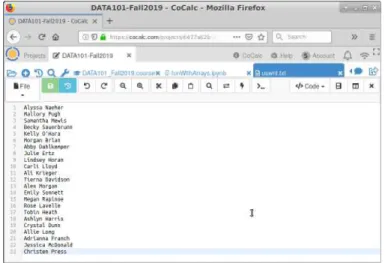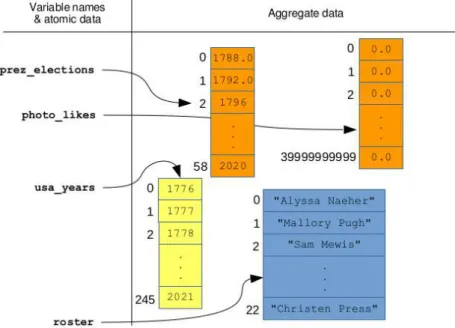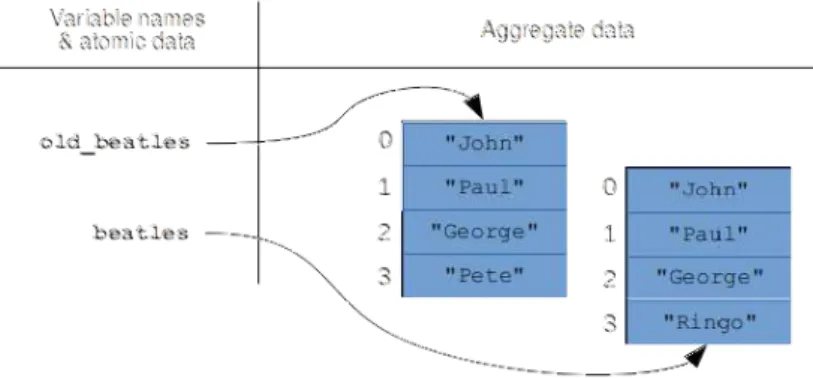No matter how much time we spend working with data, it's never the data that actually matters—it's the real phenomenon that the data represents. Starting with the harsh and tumultuous real world and helping make smart decisions about how humanity can deal with it all: that's the big promise of the data science business.
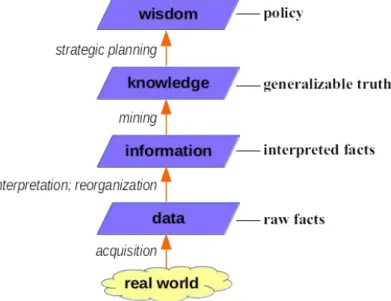
A word of warning
If you continue with this discipline, you will become highly sought after (and well paid). And it wouldn't occur to them to do that anyway - you're a wizard, after all.
Jupyter Notebooks
Run All,” the picture changes: you see the formatted message in the top cell, and the output of the Python code snippet after it has run. We haven't covered what that Python code means yet (that's the main topic of this book), but you can probably guess something of what it does.
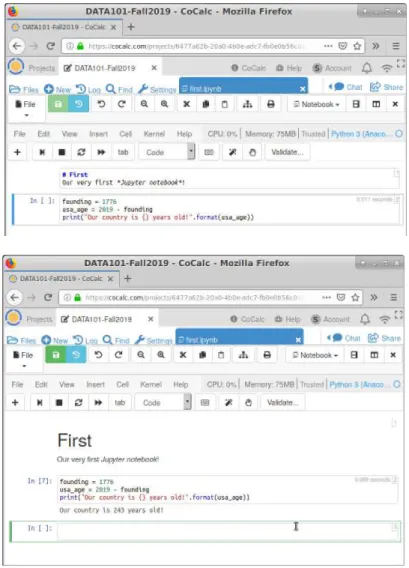
Code and output
Atomic data
Environments and variables
Each environment variable must have a different name (ie no two variables can have the same name). Although we may initially create an age variable with a value of 21, later in the program the value of the variable may change to 22, or 50, or 0.
Atomic data types
Most of the time, though, we'll treat a character sequence like "Avengers: Endgame" as a single, indivisible chunk of data the same way we treat a number like 42. At the atomic level, we will really only have to deal with the three types of this section.
The three kinds in Python
In the first example, we asked "how long is the value held in the slang variable?" The answer was 3, since "lit" is three characters. We're still calling .format() on a variable here, we just haven't bothered to name the variable.
A picture of memory
1 Another small detail you might notice: although our code has single quotes to delimit Bekka Palmer's name, I put double quotes in the box in the memory image. However, I like to put quotes in the memory images, just to emphasize the string nature of the value.
Mathematical operations
We'll get to all of them in due course (or they're all extremely Google-able if you want to look them up now). This approach will become especially useful when we get toloop in Chapter 14, because we'll be able to repeatedly increment the value of a variable by a desired amount automatically.
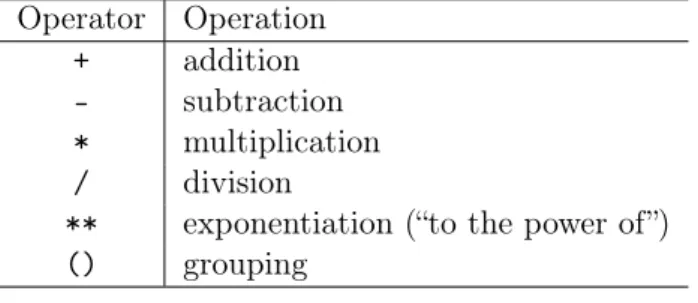
String operations
You can't see the trailing spaces in the output, but you can see the leading ones.). For example, if you asked a bunch of people in an online poll which Fredericksburg ice cream shop they like best, many of them will name Carl's: but they'll capitalize it all over, forget the apostrophe, clumsily add spaces to one end (or even both, or even the middle), but they'll all have the same delicious vanilla cones in mind.
Return values
Here we call .lstrip() on the name_of_pet variable and then store the return value back in thename_of_petvariable. This might be what you thought would happen in the first place - the author of the previous, useless line probably wanted the variable itself to permanently remove its leading spaces.
The four scales of measure
I think of the median as the "middle" value: if you line up all the events - in order of values - it's the one that's right in the middle. While the latitude plausibly has a meaningful zero point - the equator - and is therefore perhaps 'twice as north'.
Final word
Aggregate data types
All access to the associative array is through the keys: you can change the value that goes with the key, get the value that goes with the key, or even get and process all the keys and their associated values sequentially.1 In this third case, the order in which you will receive the key-value pairs is unspecified (meaning. "not guaranteed to be consistent" or "not necessarily what you would expect.") This underscores the fact that there is no sure thing. Now you may be wondering how to actually "get to" the individual table values.
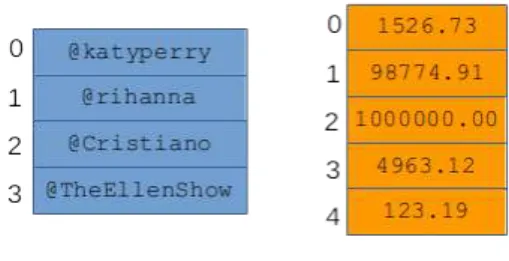
Aggregate data and memory pictures
By the way, it turns out that we will actually use the concept of a query for arrays and associative arrays as well. Another choice is the Pandas series, which we'll actually introduce in Chapter 11—strangely enough, one seems to do too much, rather than too little, for our purposes here.
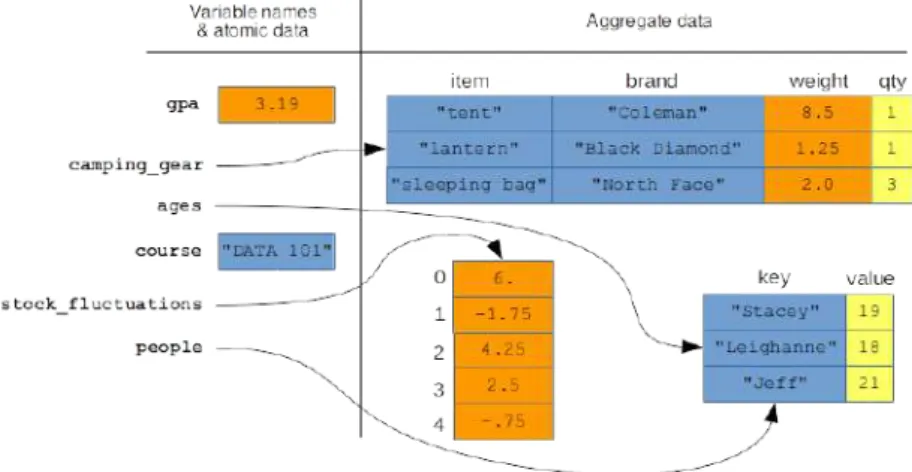
Packages
One is the regular Pythonlist, which you might have used if you've taken a computer science course in Python. This is because many, many smart people around the globe have written pieces of code to do all the common (and some not-so-common) things you want to do, and your job is to put them all together.
The NumPy ndarray
It is the modular, organized and elegant way of doing things, in addition to saving a lot of time. 8 Unfortunately, some operating systems such as Windows tend to "hide" the extension of the filenames it presents to users.
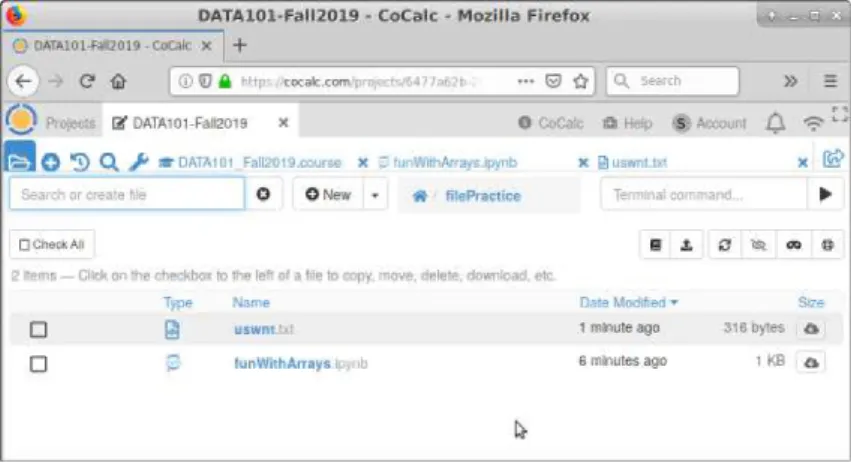
Arrays in memory pictures
Getting the array size
When you pass a string to len(), you get the number of characters; but when you pass an array to len() you get the number of elements it has. The list grid had way more than 24 letters in it, note – butlen() returned 24 as that was the number of strings.).
Accessing individual elements
The "2:6" in the box tells Python that we want a chunk with elements 2 through 5 (not 6, as you'd expect). In contrast, in the example we just did, we assigned the result of the operation back to the annex variable (salaries).
Copying – and not copying – arrays
This is another lightning-fast vectorized operation, and it works with all other mathematical operators as well. Instead of making the new variable beatlespoint to the same in-memory array that orig_beatles did, we explicitly copied the array and made beatlespoint to that new copy.
![Figure 9.1: The code on p. 79 immediately before (left side) and after (right side) the line “ stooges[1] =](https://thumb-ap.123doks.com/thumbv2/1libvncom/9201122.0/86.661.77.532.141.237/figure-code-immediately-left-right-stooges-curly-reached.webp)
Sorting arrays
Another option is to call the np.sort() function and pass the array as an object. Note that the thenfl_teams variable, although we passed it to np.sort(), was not itself sorted.
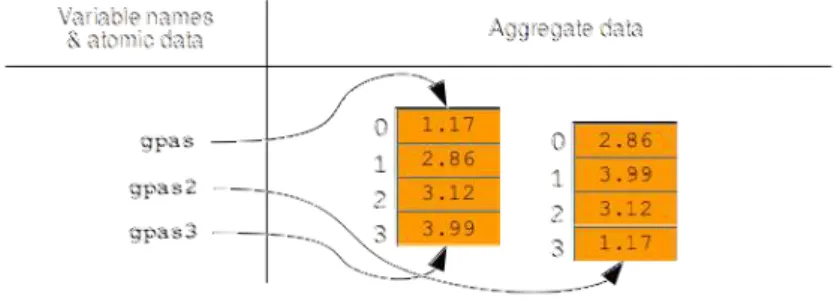
More exotic array modifications
The difference between the two is only in what is affected: one changes the actual array in memory, and the other returns a modified copy. Remember that when you call a function like this - which returns a modified copy - it's perfectly acceptable to store the returned value in the same variable you passed it.
Postlude: characters within a string
Either retrieve a specific element from an array or a specific character from a string.
Summary
Let's take a break from the nitty-gritty Python stuff and talk about how to properly interpret the data we're working with;.
Independent and dependent variables
Perhaps our subjects are American adults, and while our Categorical Variable has the values DEMOCRATIC, REPUBLICAN, OTHER, and INDEPENDENT, our numeric B is annual income. The question of interest here is: do students who apply to more colleges tend to get into UMW more often.
Association and causality
Only one of the possibilities is that "A actually causes B", which is what we suspected in the first place. The others are all ways of producing the same association that we picked up in the data.
Confounding factors
In fact, to surprise you, Figure 10-1 gives a partial list of the different kinds of causation that could be the true explanation, once we find out that A and B are related. A→C→B indirect causation People who use antiperspirant tend to get more dates, but it's not necessarily because of the antiperspirant;
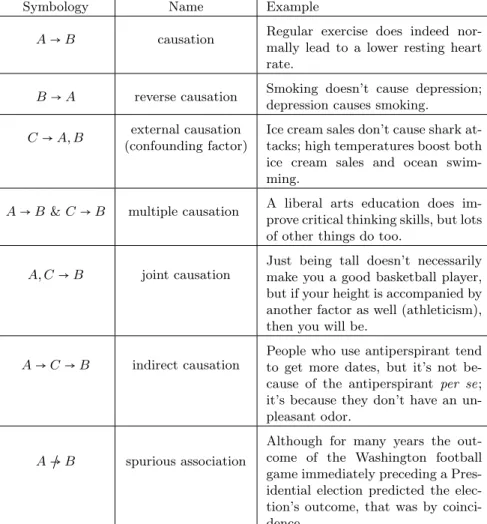
Dealing with confounding factors
A controlled experiment, on the other hand, is one in which the researcher determines what the value of the i.v. This means that no other factor can be "upstream" of the coin change and affect it in any way.

Spurious associations
The thing we determine in the stick equation, however, is how often we are willing to draw the wrong conclusion. This quantity is called “α” (pronounced “alpha”) and is a small number between 0 and 1. We will typically set α=.05, which means:.
The Pandas Series
Somewhat confusingly, the Pandas package calls the keys "the index", which is an overlap with the term we used for regular arrays (see p. 7.1). Data typically resides in sources and files outside of our programming environment, and we will do everything we can to play ball with this open universe.
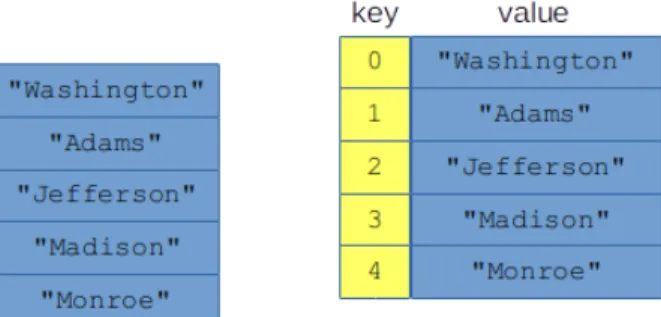
Accessing individual elements
A slightly odd thing you can do with a Pandas series is to ignore the key (index) altogether and instead use the number of the key/value pair to indicate which value you want. Similarly, you can get the key (as opposed to the value) of the key-value pair in a particular position.
Vectorized arithmetic operators
Jim has a current salary of $100,200 in the first series, but has no value at all in the second (no raise for Jim this year? For example, maybe your company has a standard entry-level salary that every employee receives that is not specified in the salary series.
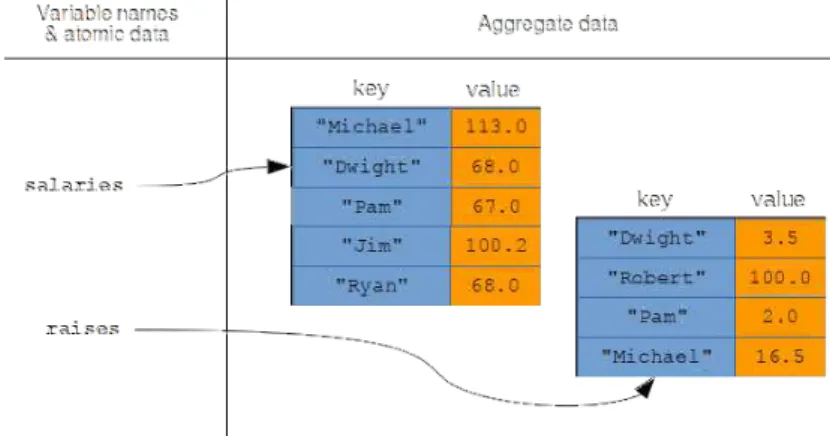
Copying Serieses
Sorting Serieses
Like NumPy's np.sort() function (but unlike the .sort() method; .. refer back to Section 9.5 on p. 81 for details), none of these methods actually sort the array into place; instead, they return collated copies.
Concatenating and combining
Summary
Use NaN for the value of any key that does not appear in both ser1 and ser2. Theidxminandidxmax are 12 and 4, respectively, since the smallest value in the array (the3) has a key of 12 and the largest value (the15) has a key of 4.
Queries
Here we ask for all key/value pairs where the key is greater than ten, or the value is greater than ten, or both. In English we said "give me elements whose key is not greater than ten, or the value is greater than ten, or both." The four corresponding elements are shown above.
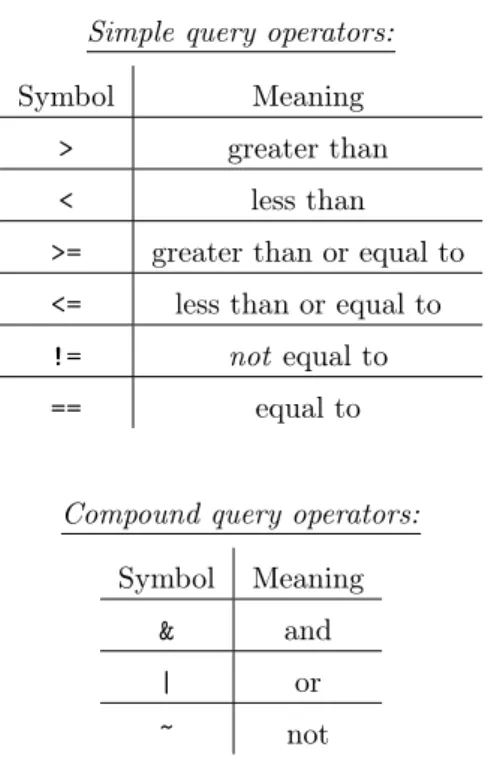
The two species of loops
Until now, all of our Python programs have run step by step, from start to finish, like a metronome, with each line of code being executed exactly once. In this chapter, we introduce the concept of a loop, which is a programming construct that directs lines of code to be executed repeatedly, and out of strict sequence.
A word of caution
Iterating through an array
The loop body consists of all the consecutive following lines that are indented one tab (over-over).2. The second time we executed line 3, we setv (sometimes called the loop variable, by the way) to the second element of the array, "Ursula".
Iterating through the values of a Series
Don't miss the fact that the "scary!" and "has n letters" messages were printed four times each, while "Whew!" appeared only once. Note that "loop through the series" actually means "loop through the values of the series", not the keys.
Iterating through the keys of a Series
By the way, you can see that the name of the loop variable is completely up to you. But that's really up to you: it has nothing to do with the name of the Series itself.
Iterating through the keys and values of a Series
I called the former "hero" and this "secret_identity" only because those names reflected their content. If we freeze the program only after the third execution of the loop head this time, we get the picture in Figure 14.2.
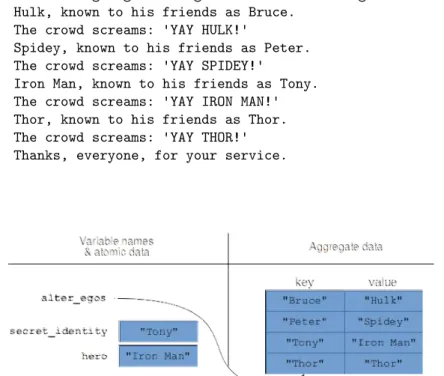
Wrapping up
In this chapter, we'll learn some basic EDA techniques for univariate data, which is really all we've studied so far. First, we'll look at summary statistics, which is a way to capture the general characteristics of a data set so you can see the forest instead of just a bunch of trees.
Categorical data: counts of occurrences
The.value_counts() method returns another series, but the values of the original series become the keys of the new one. And all you have to do is call .value_counts() and look at the top result. In this case, Taylor Swift.).
Numerical data: quantiles
It is the value that half of the data points are below and half are above. Because of how quantiles work, exactly 50% of the data points are between the .25 and .75 quantiles.
Numerical data: other summary statistics
I think you'll agree that it's nonsensical to claim that "the typical play count is 14,018" however you slice it. The standard deviation, like the IQR, is a measure of the "spread" of a dataset – a high number means (in this example) a higher variability in the number of times videos are played.
Plotting univariate data
A very common special case of a bar chart is one where we combine it with the .value_counts() method. The .sort_values() method was not needed here because our friend .value_counts() already returns its answer in descending numerical order.
Numerical data: histograms
Here we specifically asked for thirty bins in total, and we get the result in Figure 15.2. Another reasonable answer would be "somewhere in the low hundreds," since there are quite a few videos in that range, as illustrated by the right side of Figure 15.4.
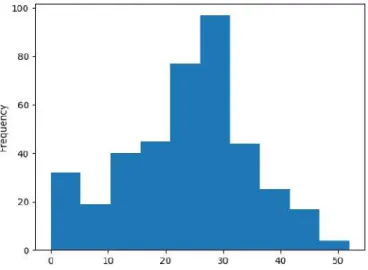
Numerical data: box plots
While the whiskers show the full range of data, the box shows the middle 50% of that data. This makes it very easy to see where most of the data is located and reinforces the lesson we learned from the histogram on this data set (Figure 15.1 on page 161): a.
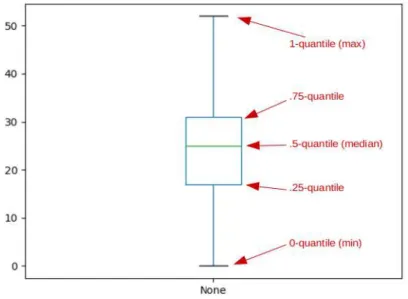
Reading a DataFrame from a .csv file
This tells Pandas that one of the columns in the DataFrame should be designated as the index (or keys). In the output above, you may notice that the word "person" is printed somewhat lower than the other column names.
Missing values
In the DataFrame we just created above, Person is obviously the right choice - it's the only one that's guaranteed to be unique.1. The new column should be—wait for it—the existing salary column, but with zeros replacing the NaNs."
Removing rows/columns
Let's talk about rows and columns first, and then we'll talk about the atomic elements ("cells") themselves.
Accessing individual rows and columns
By the way, for each of the three options, you can provide a list of multiple things you want, instead of just one. For another, it's at the bottom of one row's series instead of at the top of the other values in that row.
Accessing individual elements
By the way, you'll notice how name values are treated differently than all other columns, since name is a DataFrame index. First, the name always appears even though it is not included in the columns we requested.
Accessing a DataFrame’s metadata
Pandas treats both "axes" of aDataFrames similarly, in that they are both the same type of thing (an "Index"). Note that the name is not present in the list of column names, because as the index of the DataFrame it is a different thing.
Sorting DataFrames
You might want to sort the list alphabetically by last name, but for students with the same last name, you should go by first name as an equalizer (so Angela Smith appears after Velma Patterson but before Brad Smith). And for lines with same gender and same hair, use IQ as another equalization solution.” Look at this result and make sure it is correct.
Summary statistics for DataFrames
Queries
As with series, remember to repeat the variable name ("simpsons") before specifying the query criteria ("> 18"). To narrow it down to only specific columns, we can combine our query with the syntax of Section 17.1 (p. 177).
The .groupby() method
Think carefully: the keys of the resulting series are the values of the categorical variable (in the original series) that we grouped by; and the values of the resulting series are the results of applying the summary statistical function to each of the subsets separately. So now, in addition to knowing that the median IQ of the entire Simpson family is 95, we also know that among Simpson boys and men it's only 74, while among girls and women it's an impressive 120.
Looping with DataFrames
This is where most of the action is: you'll be amazed and impressed by how much more we can dig out of a dataset in this chapter. This is because each column of a table is a variable that corresponds one-to-one to every other column in the table.
The concept of statistical significance

